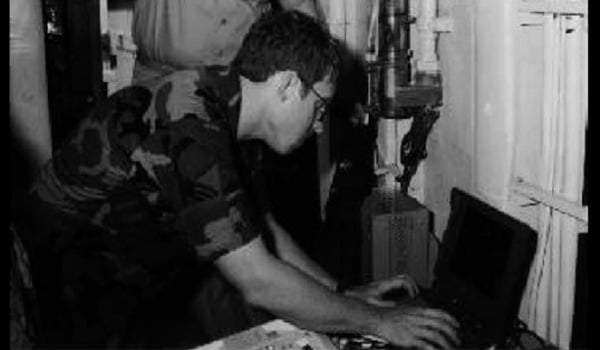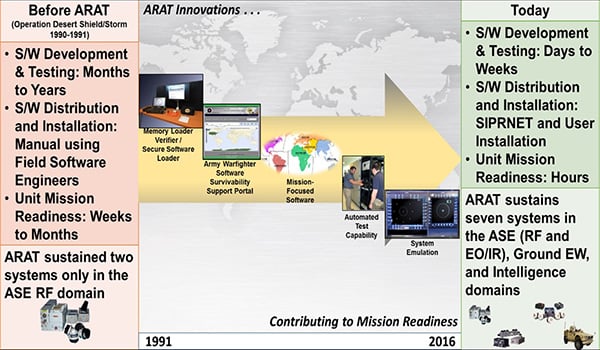
By Jason M. Juliano and Joseph S. Skarbowski: December 2016 marked the 25th year of the Army’s Rapid Software Reprogramming (RSR) infrastructure that develops, delivers and sustains software for electronic warfare (EW) systems and other electromagnetic spectrum (EMS) capabilities to support commanders across the full range of military operations. The Aviation and EW Communities know this organization as Army Materiel Command’s (AMC) Communications-Electronics Command (CECOM) Software Engineering Center (SEC) Army Reprogramming Analysis Team (ARAT).

The dispersion of aviation units during Operation “Desert Storm” highlighted the difficulties of ASE reprogramming./ PHOTO FROM DEFENSE.GOV ARCHIVE
For 25 years, ARAT software and network engineers, computer scientists, and staff specialists have dedicated themselves to protecting Soldiers and sustaining their air and ground systems, enabling them to accomplish the Army’s mission: fight and win our Nation’s wars. Focused on quality, efficiency, rapid software reprogramming and distribution, and transformation, ARAT has not only contributed to addressing a Cold War concern but has also expanded in capabilities and effectiveness to counter complex threats in today’s operational environment.
Cold War Origins
In the mid-1980s, the Army Science Board (ASB) recognized a problem in responding to threat changes in the EMS. The question wasn’t “Could the Army respond?” but “How quickly can the Army respond?” to sudden changes in the operating modes of enemy weapons systems such as radar-guided guns and missiles.
Reality confirmed the ASB’s concerns in 1998 when a training exercise named “Serene Byte” demonstrated the difficulty in rapidly responding to threat changes affecting target sensing system (TSS) performance. A greater “reality check” for the Army came during Operation Desert Shield/Storm with the challenge of reprogramming aircraft survivability equipment (ASE) on aircraft geographically dispersed across the Arabian Peninsula.

SEC ARAT, along with the USAF and USN, successfully tested innovative initial software distribution methods from the aircraft carrier USS Kennedy (CV-67) in February 1996./ U.S. ARMY ARAT-PO PHOTO
In December 1991, AMC instituted a solution to this concern by designating CECOM as the “focal point and lead major subordinate command for executing rapid software reprogramming responsibilities assigned to AMC.” Although the Army reprogramming concept, as outlined in the original Army Regulation 525-15, existed to some degree prior to this mandate, the ARAT Program Office recognizes this date as the birth of today’s ARAT infrastructure.
The First Decade (1992 – 2001)
In 1992, the ARAT organization consisted of a CECOM Software Engineering Directorate engineering team and a threat analysis capability within the Army’s Training and Doctrine Command. During its first full year of operation, ARAT, led by the Army TSS Rapid Reprogramming Project Office (ATRR-PO), sustained the AN/APR-39A(V)1 and AN/APR-39(V)2 Radar Warning Receivers, and produced a total of four software releases.
The commanding general of AMC signed a charter for the ATRR-PO in 1993 formalizing the ATRR-PO’s objectives and responsibilities for synchronizing the various elements of ARAT. Subsequent revisions to the charter refined the Project Office’s scope as it restructured from the ATRR-PO to the “ARAT-Project Office” (1996), and then to the “ARAT-Program Office” (2008).
ARAT’s drive for transformation emerged in 1994 and, with the development and incorporation of the Memory Loader/Verifiers into the reprogramming process, ARAT took the first major move towards the concept of true RSR. This device, still in use today through technology modifications, affords a significant time saving and cost-effective solution for RSR compared to prior approaches. Also that year, ARAT and the U.S. Air Force jointly developed the ARAT Bulletin Board System which served as the primary means of information transfer between ARAT sites and the global Army reprogramming community, becoming the forerunner of today’s ARAT War-fighter Survivability Software Support Portal (AWSSSP).

ARAT innovations of the past 25 years have significantly reduced the time and effort associated with Rapid Software Reprogramming. / PMO ARAT GRAPHIC
In 1997, ARAT began providing support to the Aviation Mission Planning System (AMPS). AMPS would eventually be utilized as the reprogramming platform for Aviation systems through the EW Officer Support Software, predecessor of the present-day ARAT Survivability Software Loader.
Another important development in ARAT’s first decade was the relationship building accomplished by ARAT members who conducted numerous world-wide site visits to aviation units, educating aircrews on ASE functionality and ARAT-provided services. ARAT also began software sustainment for select Air Force, Navy and Marine Corps ASE items, as well as reinforcing national Security Assistance objectives through products and technical support to foreign military sales (FMS) customers.
During the 1990s, ARAT conducted its first opportunity for reprogramming during a contingency operation when, in 1994, the Army utilized ARAT reprogrammed ASE software during “Operation Provide Comfort/Deny Flight.” Five years later, ARAT conducted its first wartime RSR for Army aviators in Kosovo during “Operation Joint Guardian,” an experience that was an invaluable precursor for another transformation that ARAT would need early in the next century.
ARAT at War (2001 – Present)
When war came to America on September 11, 2001, ARAT saw an immediate increase in its OPTEMPO. The first few days after the attacks set the beginning of a journey during which ARAT would adapt to meet the challenges of wartime software sustainment.
While supporting Soldiers in Iraq and Afghanistan remained the foremost priority for ARAT in the 2000s, its mission scope continued to grow. This included participating in the Aviation Resource Management Surveys program, assisting ASE professionals at the U.S. Army Aviation Center of Excellence, opening an infrastructure enhancement activity in Georgia, and establishing a support cell in Huntsville, AL, to support acquisition and AMC requirements.
In the 2010s, ARAT experienced a mission expansion that took it beyond software sustainment for ASE. The first growth was into the infrared spectrum with ARAT support to the AN/AAR-57 Common Missile Warning System (CMWS), followed by expansion into the ground EW domain when the CREW Duke V2/V3 transitioned to ARAT sustainment. With the introduction of both systems, ARAT developed and introduced more innovations and improvements into its software engineering environment such as automated testing, ASE display virtualization and the CMWS Integrated Support Station as featured in the October 2015 edition of ARMY AVIATION magazine.
What the Future Holds (FY 2017 and Beyond)
One can see the significance of ARAT’s mission by reviewing the numbers: software sustainment of seven mission-critical systems (installed on more than 4,000 aircraft and 30,000 ground vehicles), an annual average of 35 software releases over the past three years, upwards of 5,400 AWSSSP users, and FMS support to more than 15 nations. More importantly, ARAT’s significance is in the countless number of Soldiers protected and missions they have accomplished successfully around the globe; and ARAT does not plan to rest on its laurels as it moves into its next 25 years.
A number of challenges await ARAT in the next decade and beyond. These include the complex, congested and contested realms of cyberspace and the EMS, changes in doctrine that place increasing emphasis on Cyber Electromagnetic Activities (CEMA), and the requirements of a globally responsive, regionally focused Army.
ARAT’s responses to these challenges will include increasing automation and streamlining processes to reduce reprogramming timelines, continuing collaboration with other Army and Joint-service engineering organizations to leverage complementary capabilities, training and retaining the best engineering talent available, and providing Soldiers with the tools needed to enable efficient software installation and effective ASE employment. With a vision of being the Army’s premier organization providing RSR, and employing a core competency of synergizing organic capabilities to rapidly respond to the needs of the Army, other Services, Allies and non-DoD agencies, ARAT looks to 2017 and beyond to continue writing the chapters of its history in support of America’s commanders and their Soldiers.
Mr. Jason M. Juliano is the ARAT Program Officer at Aberdeen Proving Ground, MD; and Mr. Joseph Skarbowski provides contractor support to the SEC ARAT-PO as the Future Operations Officer.
























